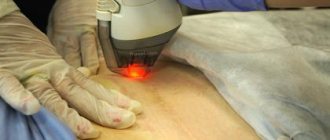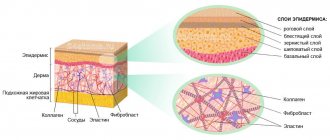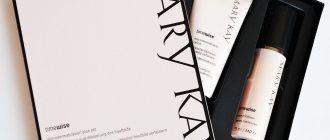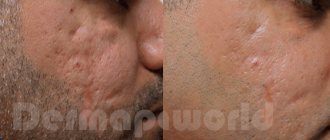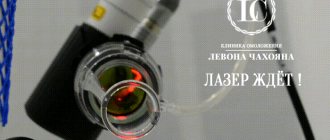Fractional ablative laser skin rejuvenation, or fractional skin resurfacing, is rightfully considered one of the most effective procedures in modern cosmetology for solving various dermatological problems and structural skin rejuvenation. Ablation (from the Latin ablatio - removal, elimination) is a process of targeted, controlled removal of a certain part of the skin using a laser beam to the entire controlled depth of its penetration. In the slang of cosmetologists, such an effect is usually called “laser skin drilling”
CO2 laser skin resurfacing
CO2 laser skin resurfacing is a procedure that uses carbon dioxide (CO2) and a laser to remove scars, warts, stretch marks and deep wrinkles. Using this method, you can reduce the appearance of several signs of aging and get rid of some other imperfections.
The device uses intense light power to treat many aesthetic problems. Drooping bags under the eyes, acne scars and age spots are some of the most common problems that are addressed to cosmetology centers in Moscow and other cities. The procedure has a fairly high price, but if used correctly, this type of hardware intervention can significantly delay the need for surgical intervention.
Indications and contraindications
The list of indications for the procedure is extremely extensive. Most often this is:
- post-acne - retracted scars or spots after acne treatment on the face;
- acne (pimples and ulcers);
- scars after injuries and operations;
- fine wrinkles;
- severe ptosis, sagging, loss of firmness and elasticity of the skin;
- rosacea, enlarged pores;
- pronounced vascular network;
- stretch marks, stretch marks;
- pigment spots of various origins.
The procedure will also be effective if you need to “deal” with several types of defects at once - for example, remove scars and simultaneously perform rejuvenation.
There are few contraindications, but they still exist:
- children's age (up to 18 years);
- pregnancy and lactation;
- infectious diseases in the acute phase;
- inflammatory processes on the skin, allergies, rashes;
- fresh wounds and injuries;
- history of cancer:
- chronic endocrine disorders.
How does CO2 laser resurfacing work?
Ablative lasers, such as the CO2 laser, cause damage to the skin. The procedure removes a thin surface layer (epidermis) and heats the underlying layer (dermis). This stimulates the growth of new collagen fibers, the synthesis of which is slowed down for one reason or another. As the skin heals and new epidermal cells form, the treated skin becomes clearer, smoother, and firmer. Renewed skin is better supplied with blood and nutrients and absorbs care products better.
A similar effect can be achieved using non-ablative lasers such as pulsed light (IPL) devices. They do not damage the skin, but instead stimulate collagen synthesis and improve tone and texture. It is less invasive and requires less recovery time, while at the same time being less effective.
The cosmetologist chooses the type of laser depending on the patient’s existing problems and cosmetic goals.
The principle of laser action on scars
Any scar - after acne, burns, surgery or injury - consists of connective tissue, that is, many collagen fibers, between which lies a “layer” of hyaluronic acid. When a scar is “young,” it still has capillaries that give it a reddish color. After a year, the vessels are penetrated by collagen fibers and disappear - the scar becomes white.
There is normal skin around the scar. It has an upper layer - the epidermis, and a lower one, which, like the scar itself, contains collagen, elastin fibers and hyaluronic acid. But the dermis (deep layer) differs from scar tissue: in addition to blood vessels and various glands, it contains fibroblast cells. They have the ability to synthesize new skin.
Fractional laser is a beam of beams coming at a short distance from each other. They have high energy and when they come into contact with human tissue, they evaporate it. These rays are directed simultaneously to the scar (even if it is on the face) and to the skin around it. Then it evaporates individual columns of tissue, resulting in the following actions:
- due to the disappeared “columns” in the area of the scar itself, it “shrinks”;
- evaporation of fibroblasts along the periphery of the scar gives the remaining similar cells a “command” to synthesize new skin.
As a result, the “newborn” integumentary tissue “creeps” onto the scar, which is decreasing in volume, from all sides - along its perimeter, and additionally displaces it.
What are the benefits of carbon dioxide laser resurfacing?
CO2 laser skin resurfacing
Skin resurfacing using a CO2 laser can be used for the following cosmetic defects:
- Fine and deep wrinkles
- Age spots
- Uneven shade or texture
- Sun damaged skin
- Mild to moderate acne scars
- Large pores
- Superficial or deep hyperpigmentation.
Other applications of carbon dioxide grinding include:
- Seborrheic keratosis
- Non-malignant neoplasms of HPV
- Hyperplasia of the sebaceous glands
- Angiofibroma (fibrous nasal papule)
- Connective and complex nevi
- Lentigo spots
- Syringomas (intradermal papules)
- Epidermal melasma (increased skin pigmentation)
- Rhinophyma (tissue hypertrophy on the nose)
How to treat fresh scars?
To speed up healing and prevent the formation of rough scar tissue, conservative treatment of fresh scars and stretch marks should be carried out. This will allow you to get a neat, tight scar, sometimes almost invisible, which will significantly reduce the number of laser resurfacings. Excellent results are obtained by plasma therapy (plasmolifting), placentotherapy, mesotherapy with anti-inflammatory and defibrosing components in combination with methyl agents for the treatment of scar tissue.
When is CO2 laser resurfacing not recommended?
Like any procedure, laser rejuvenation has contraindications. The patient must carefully read this list, since laser exposure to the skin is a serious intervention with a risk of complications. Skin resurfacing is not recommended in the following cases:
- Active bacterial, viral or fungal infections
- Poor general health, inflammatory processes in the body
- Taking oral isotretinoin (Accutane) within the past 6 months
- Fitzpatrick skin phototypes 5-6 (very dark skin)
- Other resurfacing procedures within the previous 2-3 months
- Unwillingness to accept the possibility of complications
- Excessively thick or thin skin (determined by a doctor during consultation)
- Collagen vascular diseases
- Human immunodeficiency virus (HIV) or systemic infections
- Tendency to form keloid scars
- Metal piercing in the treated area
How does laser work in scar treatment?
Laser scar treatment is the only procedure that can reduce the depth of scars and eliminate them permanently.
The essence of laser scar treatment is to remove the top layers of skin along with scar tissue. At the same time, restoration processes in the treated areas are enhanced, new young collagen and elastin are synthesized, which leads to the formation of a normal structure of the dermis.
It should be noted that red fresh scars and keloid scars are not always indications for scar resurfacing. As a rule, you should wait until the inflammation subsides and the formation of scar tissue stops before performing the laser scar removal procedure. On average, this process takes up to six months.
Is resurfacing with a CO2 laser painful and what to expect after?
This procedure is usually performed under anesthesia, so discomfort is minimal. This is a numbing cream that is applied directly to the skin. Other types of anesthesia are performed in selected situations and skin conditions that require deeper laser penetration.
After exposure to CO2 you can expect to feel a slight sunburn. You will also notice redness and swelling on the skin. Itching and mild tingling for several days are common. Depending on the intensity of treatment, the “sunburn” effect may be weaker or more severe. In these more severe cases of redness, scabs may appear as the skin heals.
At what age is the procedure indicated?
- Fractional CO2 exposure-resurfacing is done when indicated and is performed on patients over 18 years of age.
- Fractional CO2 exposure-rejuvenation is recommended for patients over 30 years of age.
The presence of indications and the absence of contraindications are the main criteria for choosing a technique.
The patient's main complaint: laxity above the navel and excess skin.
Post-procedure care
Do not touch or rub your skin when brushing or showering, and avoid contact with hot water. The treated area must be cleaned 2 to 5 times a day, and also include protective products in your care that the cosmetologist will recommend.
The treatment area is peeled off during the recovery period to allow new cells to come to the surface. The new skin will be pink, like after a major scratch. Over time, the pinkness will go away, and during this period it is important to protect yourself from external influences, especially ultraviolet rays. Redness tends to last longer in people with fair skin, such as blondes and redheads. Full recovery may take up to a year.
There are several types of hardened scars:
- Normotrophic. This is the classic picture of healed tissue. They are pale and do not stand out above the skin.
- Keloids. Usually bluish or bright pink in color, stand out above the surface of the skin, often lumpy. These scars occur after an emergency caesarean section or any other emergency surgery on the chest or near the groin area. In this case, laser scar removal requires more procedures and sometimes drug therapy.
- Atrophic. The scars are slightly retracted into the skin and can be either flesh-colored or bluish in color. A striking example is post-acne marks, stagnant spots, stretch marks.
- Hypertrophic. These are dense scars that rise above the skin, usually pinkish in color, but lighten over time. Often occur at the site of burns and deep lacerations.
Laser resurfacing, which our clinic in North-West Administrative District offers, treats all types of scars, but some of them cannot be completely removed: they can only be smoothed out or lightened.
How long does it take for the treated area to heal?
Facial restoration after CO2 laser resurfacing takes from 7 to 14 days, depending on the depth of beam penetration. After the procedure, swelling occurs. It peaks on the second or third day and then subsides by the fifth or seventh day. Redness and itching are normal and should not be a cause for concern. During the first week, varying degrees of crust formation are observed. It is necessary to apply open or closed dressings until complete healing.
Apply a light, water-based moisturizer for the next 2-3 weeks. Avoid products containing acids such as salicylic, glycolic, etc. in your daily care until the skin is completely restored. After healing, use sunscreen.
A return visit to the clinic where the procedure was performed is usually required after 2-3 days, then a week, 3-4 weeks, 3 months, 6 months and 1 year after resurfacing.
How many treatments are needed to remove scars?
The number of procedures depends on the age, type and size of the scar. Normotrophic scars are most favorable for correction. Atrophic scars (for example, post-acne scars) can completely disappear either after one procedure or after a series of laser resurfacing, which is determined by the depth of the scars. Correction of large hypertrophic scars is complex and requires multiple resurfacings. The most difficult to correct are keloid scars; the question of the advisability of their resurfacing is decided individually, and, as a rule, is accompanied by drug therapy. After the first resurfacing, the scar is usually reduced by 20-30%.
What are the possible side effects of CO2 laser resurfacing?
The following transient side effects may occur after exposure to a fractional laser:
- Swelling
- Erythema (redness)
- Itching
- The appearance of acne
- Hyperpigmentation
- Infection (bacterial, viral, fungal)
- Contact dermatitis
- Hypopigmentation (loss of skin pigment)
- Demarcation lines
- Hypertrophic scars and keloids
- Damage to tooth enamel
- Eye injuries
- Post-inflammatory hyperpigmentation
How does the procedure work?
As mentioned above, the fractional photothermolysis procedure is very comfortable:
- The patient sits on a comfortable soft couch.
- The cosmetologist cleanses the skin in the treatment area from contaminants (dust, sweat), if necessary, performs makeup removal and treats the area with an antiseptic.
- The device is configured in accordance with the objectives of the procedure.
- The specialist treats the problem area using a special nozzle. The maximum that the patient experiences is a feeling of intense warmth and tingling. The depth and power of the impact can be adjusted during the process if necessary.
- At the end of the procedure, the cosmetologist disinfects the treated area and applies a light soothing cream to it.
